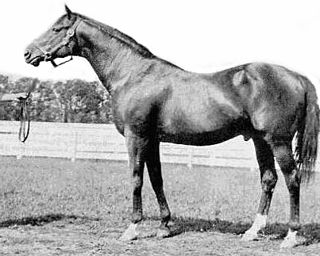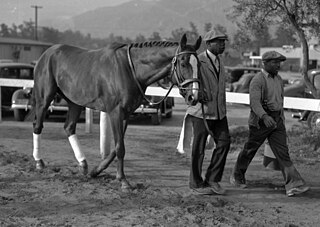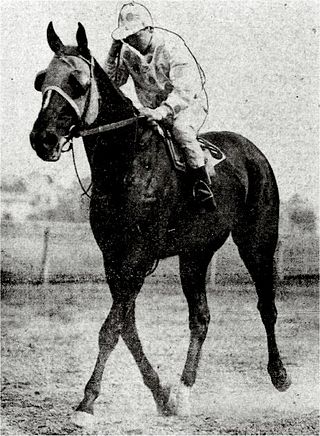Related Research Articles

Secretariat, also known as Big Red, was a champion American thoroughbred racehorse who was the ninth winner of the American Triple Crown, setting and still holding the fastest time record in all three of its constituent races. He is widely considered to be the greatest North American racehorse of all time. He became the first Triple Crown winner in 25 years and his record-breaking victory in the Belmont Stakes, which he won by 31 lengths, is often considered the greatest race ever run by a thoroughbred racehorse. During his racing career, he won five Eclipse Awards, including Horse of the Year honors at ages two and three. He was nominated to the National Museum of Racing and Hall of Fame in 1974. In the Blood-Horse magazine List of the Top 100 U.S. Racehorses of the 20th Century, Secretariat was second to Man o' War.

Colin was an undefeated champion American Thoroughbred racehorse who won all his 15 races including the 1908 Belmont Stakes and was the 1907 and 1908 Horse of the Year as well as the 1907 Champion Two-Year-Old Male and 1908 Champion 3-Year-Old Male and was inducted into the National Museum of Racing and Hall of Fame.
Helen Bates "Penny" Chenery was an American sportswoman who bred and owned Secretariat, the 1973 winner of the Triple Crown. The youngest of three children, she graduated from The Madeira School in 1939 and earned a Bachelor of Arts from Smith College, then studied at the Columbia Business School, where she met her future husband, John Tweedy, Sr., a Columbia Law School graduate. In March 2011, Randolph-Macon College in Ashland, Virginia, awarded Chenery an Honorary Doctor of Laws degree.
First Landing was an American Thoroughbred racehorse.
Christopher Chenery was an American engineer, businessman, and the owner/breeder of record for Thoroughbred horse racing's U.S. Triple Crown champion Secretariat.
Hill Prince (1947–1970) was an American Thoroughbred racehorse. He was one of the leading American two-year-olds of 1949, alongside Oil Capitol and Middleground. In 1950, he ran fifteen times, winning races including the Preakness Stakes, Wood Memorial Stakes, Withers Stakes, American Derby, Jockey Club Gold Cup, Jerome Handicap and Sunset Handicap and being named American Horse of the Year. Hill Prince raced for two further seasons and had some success despite a number of injuries and training problems. He later became a moderately successful breeding stallion.
Riva Ridge was a Thoroughbred racehorse, the winner of the Kentucky Derby and Belmont Stakes in 1972.
Xalapa Farm is an American thoroughbred horse breeding stable near Paris, Kentucky.

Discovery (1931–1958) was a champion American Thoroughbred racehorse. In a racing career which lasted from 1933 to 1936 he ran sixty-three times and won twenty-seven races. One of the leading American three-year-olds of his generation in 1934, he became a dominant performer in the next two seasons. The National Museum of Racing and Hall of Fame said that he was: "...considered one of the greatest horses of the 20th century."
The Cicada Stakes is an American Thoroughbred horse race run annually at Aqueduct Racetrack in Queens, New York. Inaugurated in 1993, the Cicada Stakes was run at a distance of seven furlongs until 2006 when it was modified to six furlongs. It is a black type stakes race with a purse of $100,000 and has been a prep race to the Triple Tiara of Thoroughbred Racing, including the Kentucky Oaks, the Black-Eyed Susan Stakes and Mother Goose Stakes.
Somethingroyal was an American Thoroughbred racehorse best known as the dam of the 1973 U.S. Triple Crown champion and Hall of Fame inductee Secretariat. She also produced three other stakes winners and was named the 1973 Kentucky Broodmare of the Year.

Peter Pan (1904–1933) was an American Thoroughbred racehorse and sire, bred and raced by prominent horseman, James R. Keene. As winner of the Belmont Stakes, the Brooklyn Derby and the Brighton Handicap, he was later inducted into the National Museum of Racing and Hall of Fame. His progeny included many famous American racehorses, including several winners of the Kentucky Derby and the Preakness Stakes.
Cicada was an American Thoroughbred racehorse who was the first filly in American racing history to be awarded consecutive championships at the ages of two, three and four. She was inducted into the National Museum of Racing and Hall of Fame in 1967.
Flaming Page was a Canadian Thoroughbred who was a Champion racehorse and then an outstanding broodmare. She is best known as the dam of English Triple Crown winner Nijinsky. She was elected to the Canadian Horse Racing Hall of Fame in 1980.
The National Stallion Stakes was an American Thoroughbred horse race held sixty-two times between 1898 and 1971. Inaugurated as the National Stallion Race at Morris Park Racecourse in The Bronx, the event was open to horses of either sex until 1948 when it became a race exclusively for colts and geldings and a National Stallion Stakes was created. Contested on dirt at a distance of five furlongs, from 1905 onward it was hosted by Belmont Park in Elmont, New York except for 1963 through 1967 when it was run at Aqueduct Racetrack in South Ozone Park, Queens, New York.
The Astarita Stakes was an American Thoroughbred horse race run between 1946 and 2005 at New York's Aqueduct Racetrack in South Ozone Park, Queens and at Belmont Park in Elmont. Open to two-year-old fillies, it was a sprint race contested on dirt over a distance of six and a half furlongs. It offered a purse of $100,000.
Arthur B. "Bull" Hancock Jr. was a breeder and owner of thoroughbred racehorses at Claiborne Farm in Paris, Kentucky, United States. He acquired European horses to breed in the United States, in particular Nasrullah and Princequillo, and gained great standing in the racing world as a result.
Challenger (1927–1948) was a British Thoroughbred racehorse who became a Leading sire in North America.
James Homer "Casey" Hayes was an American Thoroughbred racehorse trainer whose horses won eight national Championship titles of which two were inducted in the National Museum of Racing and Hall of Fame.
The National Stallion Stakes was an American Thoroughbred horse race for two-year-old fillies held annually for the twenty-four years between 1948 through 1971. It was created as a counterpart to the National Stallion Stakes which was first run in 1898 at Morris Park Racecourse and was open to horses of either sex until 1948 when it became a race exclusively for colts and geldings. Contested on dirt at a distance of five and one half furlongs, the filly division was hosted by Belmont Park in Elmont, New York except for 1963 through 1967 when it was run at Aqueduct Racetrack in South Ozone Park, Queens, New York.